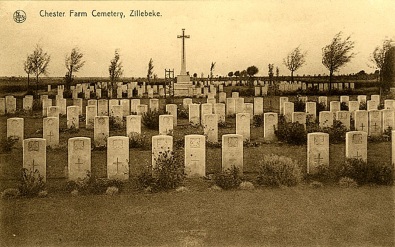Alfred Ball’s war got off to something of a slow start. The battalion, stationed on The Strand in August 1914 was moved to Bedmond (near Hemel Hempstead) and then Watford before mobilisation to France in March 1915. Alfred appears not to have always travelled with them to the front line according to De Ruvigny’s roll of honour – his experience in physical instruction being of value, he also spent a time acting as a temporary quartermaster sergeant and “instructing men in the use of musketry.”
 His medal card shown here indicates he was awarded the three medals to those soldiers serving in 1914 – the Victory medal, the British medal and the Star – affectionately known as “Pip, Squeak and Wilfred.”
His medal card shown here indicates he was awarded the three medals to those soldiers serving in 1914 – the Victory medal, the British medal and the Star – affectionately known as “Pip, Squeak and Wilfred.”
Whether of his own volition or not, Ball was transferred back to his battalion on the front in December 1916. If he volunteered to do so or not remains unknown, but this certainly would be in keeping with a number of other young men and Saracens who chose front line service with their pals over administration duties behind the lines.
His Battalion had been depleted by involvement in the action around Butte de Warlencourt – an ancient burial mound in the north of France, on which the Germans placed artillery spotters – so experienced heads such as Alfred’s would have been highly valued amongst the ranks.
The battalion was spared any large scale assaults in the early months of 1917. June, however, brought the offensive at Messines Ridge, which was a notable Allied success with effective use of the rolling barrage, started following the detonation of 19 large mines under the German front line at 3:10 am on 7th June.
This is commonly considered the largest planned explosion in history until nuclear weapons testing in 1945, and killed more people than any other non-nuclear explosion in history. Alfred would have witnessed, first-hand, the ground shaking horror of the explosion. Messines Ridge is also venerated as a noted Anzac battlefield, with the modern town housing a statue to commemorate New Zealanders who fought in the battle.
With casualties evenly balanced, and a significant advance and capture of the town of Messines itself, the battle is often hailed as a success. Whilst the main bulk of the assault was over within the week, attacks continued against a weakened German line, and in early July the Civil Service Rifles were in place, continuing to harass the line whilst the main army built toward the 3rd Battle of Ypres.
 It was to be the 3rd of July 1917 that Alfred’s luck finally ran out.
It was to be the 3rd of July 1917 that Alfred’s luck finally ran out.
Captain L. F. Burtt wrote in a letter to Alfred’s parents: “We were just coming out of the trenches when a shell landed right amongst us, killing your son…he was liked by everybody, and has left a gap in their lives.”
Alfred was buried at Chester Farm Cemetery in the Ypres salient.

“AS HE LIVED SO HE DIED A NOBLE DEATH” AA Ball headstone tribute
His life, service, sacrifice and his membership of Saracens Rugby Club were all commemorated in De Ruvigny’s ‘Roll of Honour’ publication.

Pingback: The Enlisted Civil Servant – Alfred Austin Ball – Saracens “B” Team Captain 1913-14 | Saracens Rugby Club and W.W.1
Pingback: Finding Our Fallen Saracens….Touring the Battlefield Cemeteries 2018 | Saracens Rugby Club and W.W.1